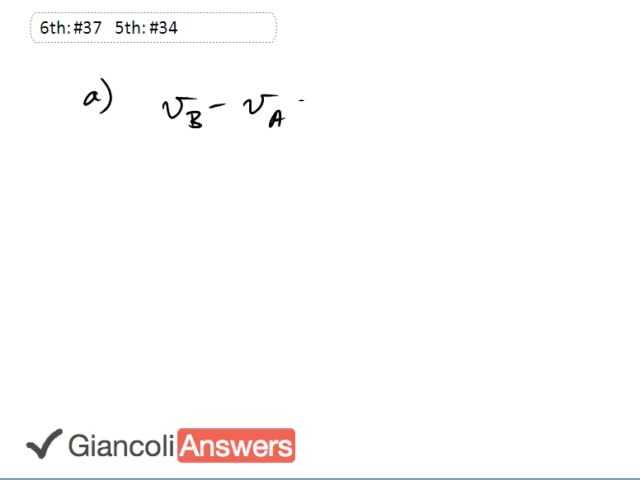
b)

In order to watch this solution you need to have a subscription.
For a perfectly elastic collision we know that ‘vB’ minus ‘vA’ will equal ‘vA`’ minus ‘vB`’, that’s from conservation of energy. And this coefficient of restitution we are told is ‘vA`’ minus ‘vB`’ divided by ‘vB’ minus ‘vA’, so that equals ‘vB’ minus ‘vA’ divided by the ‘vB’ minus ‘vA’, so this is one. So that’s the coefficient of restitution for a perfectly elastic collision. For an inelastic collision, we’ll write down the expression again: ‘vA`’ minus ‘vB`’, divided by ‘vB’ minus ‘vA’. We know that ‘vA`’ and ‘vB`’ will be the same because when they collide they’ll stick together, that’s what makes it completely inelastic. So we know that ‘vA`’ equals ‘vB`’, so then this difference on the top will be zero. So we can substitute for ‘vA`’ and write ‘vB`’ in its place. And we can see here the numerator is zero, so this whole thing is zero. And then for part b we want to show how to find the coefficient of restitution based on the heights that the ball bounces back from a heavy steel plate. So let’s draw the plate here, the ball will fall from this initial height ‘h’ then it will have some velocity here, let’s call this ‘vA’ at the very bottom of its travel, so right before it hits the plate and suppose that final velocity is ‘vA’, so it starts from rest at height ‘h’ and then free falls until it hits the plate and then it will bounce back and it’ll have some height ‘h`’. And after it bounces it will have some velocity ‘vA`’. And we are going to figure out what each of these velocities are and then see how they are related to the heights. We’ll use the equation: ‘vf’ squared equals ‘vi’ squared plus two ‘a’ times ‘d’. ‘vA’ is going to be the final velocity after free falling from height ‘h’, so we solve for that: ‘vA’ is going to start from rest, so I’m imagining that the initial velocity is zero, so ‘vA’ is going to be just the square root of two times the acceleration is ‘g’ times the height here is ‘h’ and since it’s going downwards, we put a negative in front of that. For ‘vA`’ after the bounce, it’s going to have a final velocity of zero when it gets to the maximum height and the initial velocity is what we are interested in at this point. So the initial velocity is going to be the ‘vA`’, and that’s going to be: square root two ‘g’ times ‘h’, and it will be positive because it is going upwards. Now the coefficient of restitution, ‘e’ equals ‘vA`’ minus ‘vB`’ divided by ‘vB’ minus ‘vA’. ‘vB`’ is zero and ‘vB’ also is zero because the steel plate is initially at rest so it’s clear that ‘vB’ should be zero and when the ball hits it and bounces off we are told that the steel plate is a heavy steel plate and that’s the clue that it’s not going to recoil much at all, so we’ll essentially say that ‘vB’ is zero. And so what we have here is just the ‘vA`’ and the ‘vA’. So we’ll make substitutions: negative square root two ‘g’ times ‘h’ minus zero, divided by zero minus square root two ‘g’ times ‘h`’, so we have: ‘e’ equals the square root of ‘h`’ over ‘h’ which is our answer to part b.